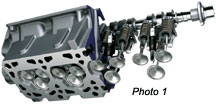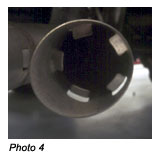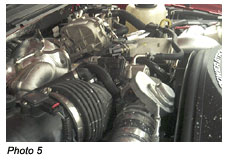A
bold new look and some subtle changes probably best describe the
2004-and-up Ford F-150. To the installer/engine builder, it is the subtle changes
that he or she needs to be aware of.
Spark Plugs
Watch
out when changing the spark plugs on the 5.4L three-valve engine found
in 2004-and-up F-150 and 2005-and-up Expedition and Navigator (see Photo 1).
First
of all, you’d better check your cost on the spark plugs. They are
nothing like the conventional design of a spark plug in the years past,
and the price is nothing near traditional either.
These spark plugs also use a 9/16th spark plug socket. So, if you don’t
have the right plug socket, it’s time to buy another socket before one
of these pickups roll into your shop.
When installing spark plugs, don’t just grab these puppies and start
turning on them. These things have the electrodes located about an inch
and a half away from the threads, mounted on the end of a ground
electrode shell. See Photo 2. The shell rusts from moisture.
Upon
removal, the shell can snap off in the head from a combination of the
rust and built-up carbon binding the shell in the head, and from the
shell being weakened from rusting.
To aid removal, first turn
the spark plug enough to lift the spark plug seat from the head, about
1/8th of a turn to 1/4 of a turn. Then add a tiny amount of penetrating
oil to each spark plug. Let the oil soak for about 10 minutes, then
remove the spark plugs. You may have to work the plug in and out as you
remove it. Some “screeching” sound is normal and about 33 lb.-ft. of
torque may be required to work the plug through its threading. Do not
do this on an extra-hot engine, or stone cold either. The engine should
be warm to the touch.
If a spark plug breaks off, there is a special tool and procedures for
removal. At this point, I’m going to point you to Ford TSB 06-15-02,
where it explains the special tool and procedure in the event a plug
snaps.
For installers, these trucks are not as hard to
access the plugs as with the Ford trucks in the past. The driver’s side
is fairly open, and the passenger side opens up well if you remove the
PCM and bracket. On 2007-and-up models, you’ll find wide open spaces
under the hood for easy access. Also, when replacing the spark plugs in
these trucks, be sure they’re the updated plugs.
The first
design of spark plug caused spark knocking and engine damage. Short
blocks and long blocks were replaced under warranty over this. Consult
TSB 06-03-03, or the older version 05-25-05, and make sure you’re
installing the PZT-1F-F4 spark plugs. If you’re using an aftermarket
plug, you’ll need to verify that the aftermarket plug you’re installing
is made to the same specs as the PZT-1F and not the PZT-2F. If you
install the PZT-2F or an aftermarket plug designed to match that plug,
you may end up buying someone an engine.
Oil Changes
Watch out when you change the oil on one of these three-valve engines
found on 2004-and-up F-Series. The cam sprockets are variable timing
sprockets called phasers. The cam phasers have six metal tabs that
stick out from the sides, which excite the cam sensors to tell the PCM
the exact position of the camshaft. The right-hand phaser is located
directly under the oil filler neck, and can be viewed by looking down
the neck. Occasionally, a careless oil change tech will leave the oil
gun in the filler neck and start the engine. The tabs are then bent and
broken from the phaser. This causes anything from just a check engine
light with a cam sensor code to a severe loss of power from the PCM
over-advancing the camshaft.
Diesel Exhaust Service
Another issue that an installer should be aware of, pertains to the exhaust tips found on the 2008-and-up F-Super Duty diesels.
These exhaust tips should not be removed or covered with dress sleeves that will seal off the ports on the sides. See Photo 3. As you can see, the new generation of diesel engines from all makes will have some odd-looking exhaust tips on them.
The
tips are designed to draw cool air into the tip, by use of venturi
action, to cool the exiting gases during filter regeneration. See Photo 4.
During
filter regeneration mode, the exhaust temperatures are more intense
than normal. Without the special tips, the exiting gases become
hazardous to the paint on the truck’s body, dry grass that might catch
fire or someone’s legs who happens to be standing too close to the tail
pipe.
Filter regeneration mode – another new technology
advancement that the independent tech needs to understand – will be
something you’ll see more and more in your shops.
Starting in 2008, the U.S. Environmental Protection Agency (EPA) has
thrown the diesel manufacturers a curve ball. As part of the new
regulations, these engines now have to be equipped with a particulate
filter after the catalyst. The job of the filter is to trap soot.
Periodically, the PCM performs a regeneration on the filter. During
regeneration mode, raw fuel is injected into the filter to literally
burn the soot out of the filter. The soot is reduced to ash and drops
to the bottom of the filter. The ash never leaves the particulate
filter assembly, and eventually, the filters will need to be replaced.
In time, this will open a new service market as these filters start
needing replacement.
If your shop happens to do diesel work, be advised also that these
trucks are extremely tight under the hood and cab removal is required
to do most repairs beyond basic maintenance on the Powerstroke V8
engines. See Photo 5.




Glen
Beanard is ASE-certified as a master auto technician, ASE truck
technician and ASE service consultant, as well as holding ASE
certifications in L1 and alternate fuel systems. He has completed 84
Ford training courses in his 17 years of combined automotive repair
experience between independents, national chains, fleet repair shops
and dealers, having served as both a technician and manager.













